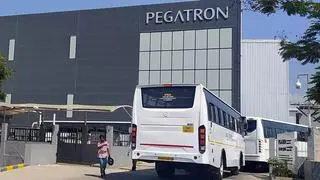Visualise these two possibilities:
Situation A : Someone in your family is admitted in hospital. The patient obviously will need an attendant by his/her side to buy the medicine prescribed (if not anything else) from the pharmacy located (invariably) within the premises. Imagine climbing the stairs or waiting for the lift every time a prescription is issued. While this gives the attendant some respite from the confines of the room, from being near the patient all the time, it may also involve a lot of running around.
Situation B : The patient has to be moved to the Intensive Care Unit (ICU)/Operation theatre. Imagine the time that one needs to wait before the stretcher or wheel chair is brought in to help move the patient. As seconds tick, the attendant's blood pressure tends to rise.
If only technology can help solve such issues….
“Oh yes, at Kovai Medical Centre and Hospital (KMCH), we have effectively used IT in healthcare logistics” says its President, U.K. Ananthapadmanabhan. The hospital is among a few others (in the city and elsewhere) to use the Pneumatic Tube Transport System (PTTS) to improve patient care.
“In the past, either the staff or the patient's attendant was involved in taking the blood/ urine sample to the Lab or buying the medicine from the pharmacy.
“With the installation of the PTS, the working atmosphere at the pharmacy and laboratory has become strangely silent since the number of encounters by staff in service areas and conversation with patients' assistants have vanished,” says Ananthapadmanabhan.
Here is how it works. Cylindrical containers called ‘carriers' or ‘canisters' are propelled through a network of tubes by compressed air or vacuum. These tubes connect the various departments in the building. The objects — be it lab sample or medicine — are placed in these carriers and closed tightly. Air is blown down/extracted from the pipeline propelling the canisters along the pipe. The hospital has commissioned 38 station PTTS and is in the process of adding another 38 stations.
Imported PVC tube network with diverters and transfer stations run along the hospital ceiling corridors, inside false ceiling (up to the top floor), to wherever the nursing stations are located. The canisters, which are about one foot long, keep shuttling in the tube, 24/7, between various PTS stations located in the laboratory, pharmacy, surgical stores, ward stations and the ICU. The movement of the loaded canisters is tracked in real time. The canisters travel at 8 metres/second.
“We commissioned this system in June 2010. The daily average transport is around 600. Our records show that before the introduction of the PTTS, 321 trips were made by patient assistants (ward boys/girls) during the morning shift alone. In the past, the ward assistants used to bunch up the samples or medicines for deliveries to reduce the number of trips they make during their shift, leading to sample mix-up, delay, annoyance and inconvenience to doctors and nurses.
The commissioning of the PTTS has helped reduce medication errors, mix-up of laboratory samples, sample misplacement and has even improved the working relationship amongst staff in the clinical support areas. Above all, it has helped prevent cross- infection as the patient assistants or ward staff need not move in and out of the patient area in their street shoes,” says the KMCH President.
Barcoded swipe card
On moving patients/shifting from ward to ICU or vice-versa, he says, “the PTTS obviously cannot be used to transport patients. We noticed the time lag in getting the ward boys to do such jobs. So we came up with the idea of bar-code”.
“Each of them is given a bar-coded swipe card. The moment the concerned ward staff places a request (on the system) for, say, a wheel-chair to transport the patient, the boy nearest on hand rolls out the chair after swiping his card to record the (wheel-out) time. He/she will have to swipe the card again after leaving the patient. A check is thus made at every stage to ensure that no time is lost in idle gossip and the patient's needs are taken care of without delay. After implementing this system, we found that the daily trips increased from 250 to around 400-450 at present”. And for KMCH, the effective implementation of IT in healthcare logistics has helped save manpower cost, increase productivity and redeploy the unskilled workforce on various other jobs such as distributing linen and instrumentation sets at the nursing station.







Comments
Comments have to be in English, and in full sentences. They cannot be abusive or personal. Please abide by our community guidelines for posting your comments.
We have migrated to a new commenting platform. If you are already a registered user of TheHindu Businessline and logged in, you may continue to engage with our articles. If you do not have an account please register and login to post comments. Users can access their older comments by logging into their accounts on Vuukle.